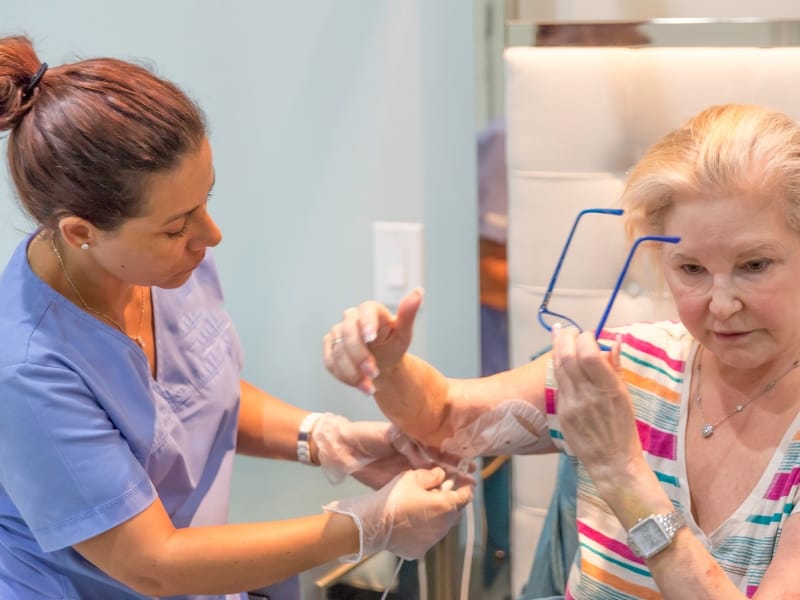Are you considering becoming a PICC nurse?
It’s an exciting career that requires specialized knowledge, training, and experience to be successful in this role.
In this blog post, I’ll discuss what it takes to become a PICC nurse, including the education requirements, roles & duties of the position, where they work, and salary expectations.
So if you’re looking into becoming a PICC nurse, read on!
What is a PICC Nurse?
The primary role of a PICC nurse is to insert and maintain peripherally inserted central catheters (PICCs) into patients’ veins. This is done so medications or fluids can be administered directly into their bloodstream over an extended period without using multiple IV sites throughout the body.
Other duties include:
- Monitoring vital signs during the procedure
- Assessing the patient’s response
- Educating the patient on proper care
- Documenting all procedures performed
- Maintaining equipment used during the procedure
- Administering medications via infusion pumps if needed
- Troubleshooting any problems that may arise during treatment
- Coordinating with other healthcare providers involved in the patient’s care plan when necessary
Education Requirements for Becoming a PICC Nurse

Becoming a PICC nurse requires specialized education and training.
To start, you must first complete an accredited nursing program and obtain your RN license. You can go here for more details on how to become a registered nurse.
In summary, here’s what you need to know:
- Take your prerequisites for nursing school.
- Find and apply to an accredited nursing program.
- Passing nursing school.
- Pass the National Council Licensure Examination, aka the NCLEX-RN.
After that, you can pursue additional education and training in vascular access, such as completing a certification program or taking courses in venipuncture and IV therapy.
The most common certification for PICC nurses is the CRNI by the Infusion Nursing Certification Corporation (INCC).
Roles & Duties of a PICC Nurse

This type of nursing requires extensive knowledge and training to ensure that the procedure is performed safely and correctly.
The primary role of a PICC nurse is to insert and maintain PICCs.
This includes assessing the patient’s condition before insertion, preparing the patient for the procedure, inserting the catheter, monitoring the patient’s condition during and after insertion, and providing ongoing care for the catheter.
Before beginning any procedure, a PICC nurse needs to assess the patient’s medical history and current health status.
They must also be aware of any potential risks or complications associated with inserting a PICC line.
Once they have assessed their patient’s condition, they can prepare them for insertion by explaining what will happen during the procedure.
During insertion, all necessary precautions must be taken to ensure safety. The nurse must also monitor vital signs closely while performing this task to detect any changes or reactions that may occur.
Once inserted successfully, it is essential that proper post-insertion care be provided, which includes:
- Changing dressings regularly if needed; checking on site integrity
- Flushing lines; administering medications when necessary
- Teaching patients how to properly manage their own line
- Monitoring vitals at regular intervals
- Addressing any concerns related to infection control practices
- Providing education about nutrition/hydration needs related to having a central line in place
Additionally, periodic assessments should be done to check site integrity and ensure no signs of infection are present around where the line was inserted.
Where Do PICC Nurses Work?
PICC nurses typically work in hospitals or other healthcare settings where they have direct contact with patients.
In a hospital setting, PICC nurses may work in an intensive care unit (ICU), medical-surgical unit, emergency department (ED), or labor and delivery ward. They often assist physicians with inserting the catheter and monitor it throughout its lifespan.
PICC nurses can also find employment opportunities outside of traditional hospital settings, such as outpatient clinics and home health agencies.
Salary of a PICC Nurse

The salary of a PICC nurse is an important factor to consider when deciding whether or not to pursue this career path.
According to ZipRecruiter, the average national wage for a PICC nurse is $91,280 per year.
At the low end, it’s $63,000 per year; at the high end, well-compensated PICC nurses can comfortably make over $100,000 per year.
As always, this salary figure will vary depending on experience level, location, and employer.
FAQs in Relation to How to Become a PICC Nurse
1. How long is PICC line training?
PICC line training typically takes between one and two days, depending on the complexity of the procedure.
The first day is usually spent in a classroom setting, learning about the anatomy of veins and how to properly insert a PICC line.
On the second day, hands-on practice with an experienced instructor is provided so that nurses can gain confidence in their ability to safely perform this important medical procedure.
Nurses may also be required to take additional courses or complete online modules for certification purposes.
2. What is a PICC certification?
PICC certification is a specialized training program for nurses who want to learn how to insert and manage peripherally inserted central catheters (PICCs).
It covers topics such as anatomy, physiology, pharmacology, infection control, patient assessment, and management.
The course also includes hands-on practice in the insertion of PICCs under the supervision of an experienced instructor.
Upon successfully completing the program, nurses are awarded a certificate demonstrating their knowledge and skills in this area.
3. Can nurses do PICC lines?
Yes, nurses can do PICC lines.
4. How long is PICC certification good for?
PICC certification is valid for two years from the date of completion.
Nurses should also stay up-to-date on any changes in standards or regulations related to PICC line insertion and management, as these may change over time.
It’s important that nurses remain knowledgeable about best practices when caring for patients with a PICC line to ensure patient safety and quality care.
Key Takeaways
Becoming a PICC nurse is an exciting and rewarding career choice. With the right education, experience, and training, you can become a certified PICC nurse and start your journey in this field.

